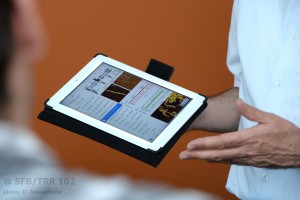An Interview with Prof. Dr. Thomas Thurn-Albrecht the Coordinator of the Collaborative Research Center.
Prof. Thurn-Albrecht, you are the coordinator of the collaborative research center ‘polymers under multiple constraints’. What are the main topics?
The central aim of our collaborative research center (CRC) between Halle and Leipzig is to study and understand the effect of different kinds of constraints on the structure formation and the molecular dynamics of polymer systems. Our investigations focus especially on problems with strong correlations between the local structure and the global conformation of the chain. Crystallization of synthetic polymers or the misfolding of proteins are prominent examples for such processes.
The national German Science Foundation (DFG) funds your research center with about 1,5 million euros per year. Why is it interesting to investigate crystallization and the misfolding of proteins? Where do you see the overlap between the two research fields?
Protein misfolding or amyloid formation is connected to specific interactions in the proteins. This is different from the crystallization of most synthetic polymers. Nevertheless in both cases we deal with molecular ordering processes of chain molecules showing a high degree of universality. For both materials the results are mesoscopic structures, which are internally heterogeneous and only partially ordered. Structure formation happens in both cases via nucleation and growth. One aim of our research center is actually to find out, if and to what extend similar concepts can be used to describe these ordering processes.
Can you give us a more detailed example for such a molecular ordering process?
One of our projects investigates the nature of cataract formation. Our eye lens contains a highly concentrated dispersion of three types of proteins, the α-, β and γ-crystallins, with high concentrations. This long-term stable protein mixture of short-range ordered crystallins provides a proper refractive index of the lens in the eye and ensures it’s transparency. The eye cataract occurs if the balance of molecular interactions and dynamics is broken. Therefore, the effects of changes in concentration on the molecular dynamics, the molecular interactions and the secondary structure are under detailed investigation via solid-state and solution NMR. We also want to contribute to the question of the subsequent conformational changes. Here crystallization, phase separation or amyloid formation are under debate.
As the CRC is an interdisciplinary research center, the questions and investigations are carried out from the point of view of physicists and chemists. Where do you see the advantages?
We are using the concepts of polymer physics to investigate processes of structure formation on a fundamental level. The collaboration between chemists and physicists brings together the knowledge and experience from our two disciplines. As a physicist I am happy about the tailored materials from my colleagues in chemistry. Without this specialization and collaboration both sides would be much more limited in the scope of their scientific work.
How many scientists and groups are involved in your CRC at Halle and Leipzig?
Our research center is very interdisciplinary and has a wide scope. Overall 15 principal investigators and about 35 doctoral students from different areas of polymer science and life sciences are involved. The activities range from synthesis of tailored polymers to the investigation of structure formation using a variety of physics based methods. Three theory groups provide the theoretical description and interpretation.
Which tools are used for these investigations?
We are investigating the polymeric systems by very different approaches. This reaches from sophisticated characterization methods of synthetic products probing molecular dynamics like broadband dielectric spectroscopy, NMR and mechanical spectroscopy to methods for structural investigations like atomic force microscopy, X-ray diffraction, scanning tunneling microscopy or differential scanning calorimetry. Just to mention a few of these methods.
What is the perspective for the next decade and what other fields of research could benefit from the research done within the CRC?
Our short-term goal is to consolidate and strengthen the recently established structures, as e.g. the graduate school, and to gain a certain visibility as a center for polymer research in the scientific community. In terms of science our aim is to make some relevant contributions to understanding the fundamental questions posed in protein aggregation and polymer crystallization. Our long-term goal is to bring knowledge and physical description in these areas to a level, where they will be broadly accepted. Concerning the last part of your question, our fields of research overlap with applied sciences like materials science and polymer engineering on the one hand, and life science on the other hand. These areas could benefit well from insights of our research.
Please comment on the recent development of the polymer research in the area of Halle and Leipzig.
Polymer research in the region of Halle has a long tradition. On this basis, we have systematically extended this area of research in the faculty over the last 10 years. This strategy together with our decision to address a combination of questions in the fields of synthetic and biological polymers has been the basis for our application for the CRC.
How do you support young scientists in the collaborative research center?
We have established an integrated graduate school within our CRC. Here the doctoral students are supported by additional research training and soft skill workshops. Furthermore, we contribute to the international Master’s course “Polymer Materials Science” of our university and the University of Applied Science Merseburg. Furthermore, talented, young scientists are integrated as PIs in the CRC with their own projects.
Why has it been attractive for you to become a member of the CRC? Where do you see the advantages of such a research center?
There are a number of reasons which make it attractive to work within the framework of a collaborative research center. Today science is very specialized and many problems can only be addresses within collaborations. The scientific exchange with colleagues on site in Halle and Leipzig is enjoyable and productive. And, given today’s funding situation and the high costs of research, we have many more possibilities with the CRC. Last but not least we think that it is helpful for the students and young scientists to get a broader view of their field. All of this of course requires an additional effort in terms of management and coordination. But I think it is worthwhile.
